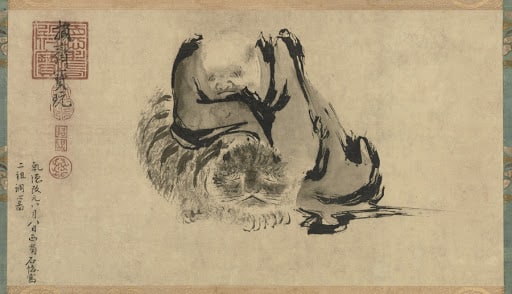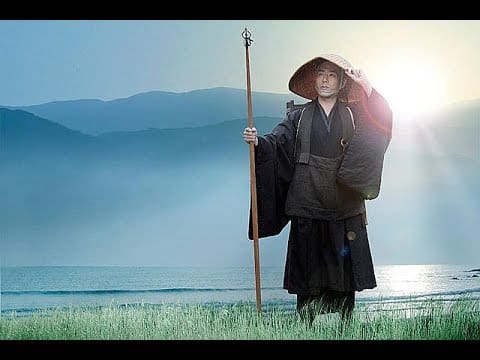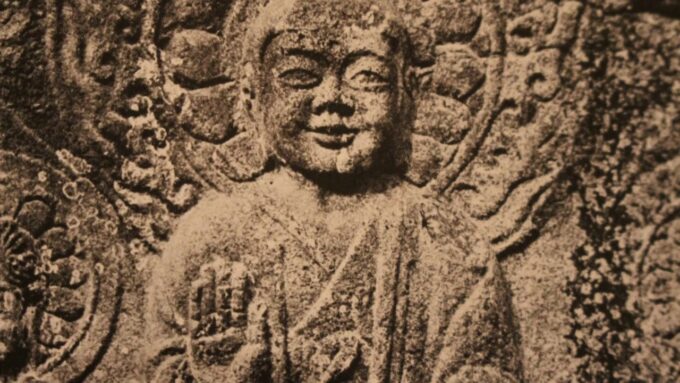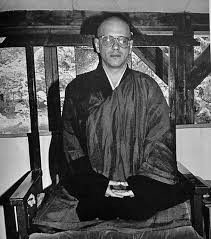Daman Hongren (Hong Ren or Hung-jen) was the well-known disciple of the Fourth Patriarch, Daoxin (Tao-hsin). He was the man history has given the title of Fifth Patriarch of the Chinese Zen Lineage. He was The Thirty-Third Buddhist Patriarch. He stepped completely into the footsteps of his master and brought the work to full bloom.
Many of the details of Hongren’s life are uncertain and much of his biography, recorded by historians long after his death, is in great measure just a legend. His personal history is similar to the previous ancestors: leaving home early to become a monk, sitting for long periods of time in meditation, abandoning the sutras, realizing enlightenment, and transmitting his teachings to a single successor.
The Chronicles (The Transmission of Light) say that he came from Daoxin’s own province and impressed the master deeply when, at age fourteen, they met while he was going to Huangmei:
Daoxin: “What is your name?”
Hongren: “I have an essence, but it is not a common name”
– What name is it?
– Is is the essence of Buddhahood
– Have you no name?
– None, because essence is empty
Hongren was a native of Huangmei in Qizhou (Hubei province), within the upper-class. He left home at about eleven or twelve to become a monk. Little is recorded of his early life, but we know that he eventually became the disciple of Daoxin. After Daoxin’s death in 651, Hongren succeeded his teacher and moved to the eastern peak of Mt. Fengmao (Donshang or East Mountain).
Hongren continued Daoxin’s tradition of establishing monastic Chan communities in which the monks worked in the fields and developed practical and administrative skills as well as engaging in meditation practice. Chan practice was extended beyond meditation to all aspects of daily life.
Hongren’s teachings came to be known as the „East Mountain Teachings” (Dongshang Famen), although that term is later applied also to the lineage and teachings of both Daoxin and Hongren. Although he was acknowledged as one of the „Lankavatara Masters,” Hongren followed Daoxin’s example and did not limit his teachings to this Sutra. Instead, he incorporated more diverse currents of Buddhist teaching into the Zen tradition. In particular, he is believed to have included portions of the Mahaprajnaparamita Sutra, especially the Heart and Diamond Sutras, as cornerstones of his teaching and practice.
The wisdom and the capacities made him famous, and it is said that eight to nine out of every ten Buddhist practitioners in China studied under him. He had many disciples, but only the names of a few remain in the record tradition, the most important one being Huineng, who, eventually, would be recognized as the Sixth Patriarch. The emperor of his time was impressed by his teachings, so he bestowed upon Hongren the title Chan master Daman (Great Abundance).
The influential „Treatise on the Essentials of Cultivating the Mind” is attributed to Hongren. This is a compilation of his teachings, presumably written just shortly after his death. „Treatise on the Essentials of Cultivating the Mind” is the earliest collection of the teachings of a Chan master.
Hongren’s basic teaching was that the Pure Mind was obscured by “discriminating thinking, false thoughts, and ascriptive views.” Eliminating false thoughts and maintaining a constant awareness of one’s natural enlightenment ensures that Nirvana naturally arises.
Hongren marks the beginning of a new period of Chan, one characterized by strong master-disciple relationships and the expanding of spiritual practice beyond the Indian dhyana meditations. Hongren’s spiritual practice was based on the “gradual enlightenment” teachings of his predecessor, Daoxin. Hongren and his monastery became the symbol of a great philosophical debate that occupied the first half of the eighth century, immortalized in the poetry contest Hongren initiated and its two main participants, Shenxiu and Huineng. This contest eventually came to symbolize the conflict between the teachings of gradual enlightenment and sudden enlightenment.
Hongren and, later, his disciples, exert an enormous influence on the religious fabric of the society. His students established three prominent Zen lineages, including the dominant „Southern School” that later encompassed the well-known „five houses” of Zen.
„People who practice mental concentration may inhibit the True Mind within themselves by being dependent on sensory perceptions, coarse states of mind, and restricted breathing. Before achieving mental purity, [such people may undertake] the constant practices of concentrating the mind and viewing the mind. Although they do so during all their activities, [such people] cannot achieve [mental] clarity and purity, nor illumine that mind which is the sources of all dharmas.”
Photo credit:chinaculturecenter




